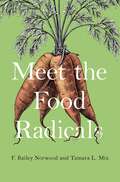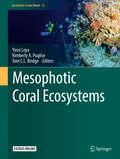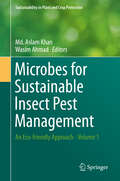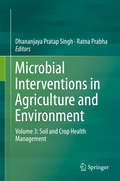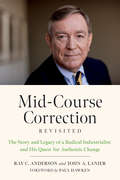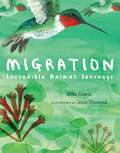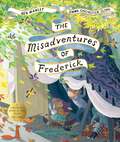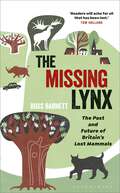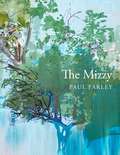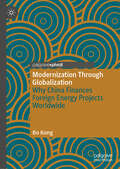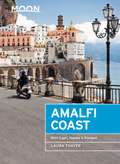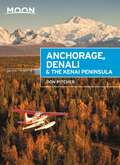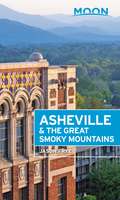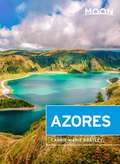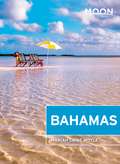- Table View
- List View
Meet the Food Radicals
by F. Bailey Norwood Tamara L. MixThe food system has changed considerably in the last century. Horsepower was replaced by machine, better crop breeding programs helped usher in the Green Revolution, and problems of malnutrition began to run parallel with those of obesity. Despite changes, many of the problems we face remain the same. Farms continue to lose soil, and low income households still have difficulty acquiring healthy food. Add to these challenges a host of new ones. Globalization has caused some agricultural communities to feel threatened. Everyone recognizes problems of malnutrition, obesity and food sustainability, but many disagree on solutions. One thing is certain: confronting both familiar and new challenges will lead to radical changes in the food system. Though the exact form of radical change is unknown, this book looks to a host of candidates by interviewing the people who champion them. We are winning the battle against soil erosion through new no-till farming methods. Progress is being made in food sustainability by a spectrum of new innovations, but also a return to traditional farming techniques. New innovations include robots on the farm, advances in molecular biology, and alternative protein sources. As we embrace the farming strategies of our ancestors, we see farms returning to polycultures, local food systems, and food sovereignty. This book gains insight from interviews with twenty-seven individuals who are either creating or proposing radical changes in how food is produced and distributed. An eclectic group ranging from farmers to activists to spiritual gurus, they are the most interesting people you have never met. By getting to know each "radical" personally we can better access their voices and visions to understand both the problems and likely solutions to today's most pressing food problems.
Mesophotic Coral Ecosystems (Coral Reefs of the World #12)
by Yossi Loya Kimberly A. Puglise Tom C.L. BridgeThis book summarizes what is known about mesophotic coral ecosystems (MCEs) geographically and by major taxa. MCEs are characterized by light-dependent corals and associated communities typically found at depths ranging from 30-40 m. and extending to over 150 m. in tropical and subtropical ecosystems. They are populated with organisms typically associated with shallow coral reefs, such as macroalgae, corals, sponges, and fishes, as well as specialist species unique to mesophotic depths. During the past decade, there has been an increasing scientific and management interest in MCEs expressed by the exponential increase in the number of publications studying this unique environment. Despite their close proximity to well-studied shallow reefs, and the growing evidence of their importance, our scientific knowledge of MCEs is still in its early stages. The topics covered in the book include: regional variation in MCEs; similarities and differences between mesophotic and shallow reef taxa, biotic and abiotic conditions, biodiversity, ecology, geomorphology, and geology; potential connectivity between MCEs and shallow reefs; MCE disturbances, conservation, and management challenges; and new technologies, key research questions/knowledge gaps, priorities, and future directions in MCE research.
Microbes and Enzymes in Soil Health and Bioremediation (Microorganisms for Sustainability #16)
by Ashok Kumar Swati SharmaMicrobial enzymes play a vital role in maintaining soil health and removing pollutants from contaminated land. Soil microflora is closely associated with maintaining soil fertility, and the use of chemical pesticides, fertilizers and other volatile sprays in agriculture threatens the health ofthe microbial population in the soil. Every single particle of healthy soil contains millions of bacteria, which interact with the nutrients available, sustaining the nutrient cycle and making this microflora an essential component of life on earth. How do microbes help in the nutrient cycle? Either by intracellular digestion of macromolecules and converting these into smaller units in their metabolic pathways, or by secreting enzymes into the extracellular environment to facilitate the conversion of complex macromolecules into micro-molecules that can be easily absorbed by other living species. To meet demands for energy and food for the growing global population, it is important to protect agricultural land from contamination and maintain its productivity. Heavy metal ions from contaminated land canenter crops, fish or aquatic organismsvia contaminated water, and theseare then taken up by the human body, where they can accumulate and alter the normal microflora.The microbiological component of the soil is ahighly complex system and is still not fully understood. How do microbes survive in the changing physicochemical environment of soil?. This book helps readers understand the mechanism, various routes of microbialsoil remediation, the interactionsof different genera, and how microbial enzymes support the sustainable restoration of healthy soil.
Microbes for Sustainable Insect Pest Management: An Eco-friendly Approach - Volume 1 (Sustainability in Plant and Crop Protection)
by Md. Aslam Khan Wasim AhmadThis Volume comprises 14 chapters in an attempt to provide the reader with available information on safe and effective use of entomopathogens. Chapters in this book dealing with soil-borne entomopathogens and their phylogeny also provide a review on most updated information of their isolation and molecular identification. Employing fungal pathogens in biological control programmes plays a key role, and conidial thermotolerance and oxidative stress are examined in separate chapters. Entomopathogenic bacteria are able to kill their hosts quickly. An important contribution concerns informations provided upon bacterial cytotoxic factors on insect haemocytes. Nematodes are biological control agents safe to the environment. The information with respect to their direct and indirect effects on non-target organisms is provided. Viruses as highly specific, virulent candidates for use as biological insecticides are safe to non-target species. A separate chapter on the role of granuloviruses in IPM contributes a wealth of information. Biopesticides in combination with synthetic insecticides are reported as effective, economic, and eco-friendly. Understanding their interactions will certainly promote their uses. Finally, emphasis has been given on reviewing synergistic and antagonistic interactions of microbial and chemical pesticides, in other chapters.
Microbial Interventions in Agriculture and Environment: Volume 1 : Research Trends, Priorities and Prospects
by Dhananjaya Pratap Singh Vijai Kumar Gupta Ratna PrabhaMicrobial communities and their functions play a crucial role in the management of ecological, environmental and agricultural health on the Earth. Microorganisms are the key identified players for plant growth promotion, plant immunization, disease suppression, induced resistance and tolerance against stresses as the indicative parameters of improved crop productivity and sustainable soil health. Beneficial belowground microbial interactions with the rhizosphere help plants mitigate drought and salinity stresses and alleviate water stresses under the unfavorable environmental conditions in the native soils. Microorganisms that are inhabitants of such environmental conditions have potential solutions for them. There are potential microbial communities that can degrade xenobiotic compounds, pesticides and toxic industrial chemicals and help remediate even heavy metals, and thus they find enormous applications in environmental remediation. Microbes have developed intrinsic metabolic capabilities with specific metabolic networks while inhabiting under specific conditions for many generations and, so play a crucial role. The book Microbial Interventions in Agriculture and Environment is an effort to compile and present a great volume of authentic, high-quality, socially-viable, practical and implementable research and technological work on microbial implications. The whole content of the volume covers protocols, methodologies, applications, interactions, role and impact of research and development aspects on microbial interventions and technological outcomes in prospects of agricultural and environmental domain including crop production, plan-soil health management, food & nutrition, nutrient recycling, land reclamation, clean water systems and agro-waste management, biodegradation & bioremediation, biomass to bioenergy, sanitation and rural livelihood security. The covered topics and sub-topics of the microbial domain have high implications for the targeted and wide readership of researchers, students, faculty and scientists working on these areas along with the agri-activists, policymakers, environmentalists, advisors etc. in the Government, industries and non-government level for reference and knowledge generation.
Microbial Interventions in Agriculture and Environment: Volume 3: Soil and Crop Health Management
by Dhananjaya Pratap Singh Ratna PrabhaMicrobial communities and their multi-functionalities play a crucial role in the management of soil and plant health, and thus help in managing agro-ecology, the environment and agriculture. Microorganisms are key players in N-fixation, nutrient acquisition, carbon sequestration, plant growth promotion, pathogen suppression, induced systemic resistance and tolerance against stresses, and these parameters are used as indicators of improved crop productivity and sustainable soil health. Beneficial belowground microbial interactions in the rhizosphere help plants combat abiotic challenges in the unfavourable environmental conditions of native soils. These microorganisms and their products offer potential solutions for agriculture in problematic areas since they are able to degrade xenobiotic compounds, pesticides and toxic chemicals and help remediate heavy metals in the rhizosphere and so make deteriorated soils suitable for crop production. This book compiles the latest research on the role of microbes in the rhizosphere and agro-ecology, covering interaction mechanisms, microbe-mediated crop production, plant and soil health management, food and nutrition, nutrient recycling, land reclamation, clean water systems, agro-waste management, biodegradation, bioremediation, biomass and bioenergy, sanitation and rural livelihood security. It is a comprehensive reference resource for agricultural activists, policymakers, environmentalists and advisors working for governments, non-governmental organizations and industries, helping them update their knowledge of this important, but often neglected, research area.
Microbial Interventions in Agriculture and Environment: Volume 2: Rhizosphere, Microbiome and Agro-ecology
by Dhananjaya Pratap Singh Vijai Kumar Gupta Ratna PrabhaMicrobial communities and their functions play a crucial role in the management of ecological, environmental and agricultural health on the Earth. Microorganisms are the key identified players for plant growth promotion, plant immunization, disease suppression, induced resistance and tolerance against stresses as the indicative parameters of improved crop productivity and sustainable soil health. Beneficial belowground microbial interactions with the rhizosphere help plants mitigate drought and salinity stresses and alleviate water stresses under the unfavorable environmental conditions in the native soils. Microorganisms that are inhabitants of such environmental conditions have potential solutions for them. There are potential microbial communities that can degrade xenobiotic compounds, pesticides and toxic industrial chemicals and help remediate even heavy metals, and thus they find enormous applications in environmental remediation. Microbes have developed intrinsic metabolic capabilities with specific metabolic networks while inhabiting under specific conditions for many generations and, so play a crucial role. The book Microbial Interventions in Agriculture and Environment is an effort to compile and present a great volume of authentic, high-quality, socially-viable, practical and implementable research and technological work on microbial implications. The whole content of the volume covers protocols, methodologies, applications, interactions, role and impact of research and development aspects on microbial interventions and technological outcomes in prospects of agricultural and environmental domain including crop production, plan-soil health management, food & nutrition, nutrient recycling, land reclamation, clean water systems and agro-waste management, biodegradation & bioremediation, biomass to bioenergy, sanitation and rural livelihood security. The covered topics and sub-topics of the microbial domain have high implications for the targeted and wide readership of researchers, students, faculty and scientists working on these areas along with the agri-activists, policymakers, environmentalists, advisors etc. in the Government, industries and non-government level for reference and knowledge generation.
Mid-Course Correction Revisited: The Story and Legacy of a Radical Industrialist and his Quest for Authentic Change
by Ray Anderson John A. LanierThe original Mid-Course Correction, published 20 years ago, became a classic in the sustainability field. It put forth a new vision for what its author, Ray C. Anderson, called the “prototypical company of the 21st century”—a restorative company that does no harm to society or the environment. In it Anderson recounts his eureka moment as founder and leader of Interface, Inc., one of the world’s largest carpet and flooring companies, and one that was doing business in all the usual ways. Bit by bit, he began learning how much environmental destruction companies like his had caused, prompting him to make a radical change. Mid-Course Correction not only outlined what eco-centered leadership looks like, it also mapped out a specific set of goals for Anderson’s company to eliminate its environmental footprint. Those goals remain visionary even today, and this second edition delves into how Interface worked toward making them a reality, birthing one of the most innovative and successful corporate sustainability efforts in the world. The new edition also explores why we need to create not only prototypical companies, but also the prototypical economy of the twenty-first century. As our global economy shifts toward sustainability, challenges like building the circular economy and reversing global warming present tremendous opportunities for business and industry. Mid-Course Correction Revisted contains a new foreword by Paul Hawken, several new chapters by Ray C. Anderson Foundation executive director John A. Lanier, and interviews with Janine Benyus, Joel Makower, Andrew Winston, Ellen MacArthur and other leaders in green enterprise, the circular economy, and biomimicry. A wide range of business readers—from sustainability professionals to green entrepreneurs to CEOs—will find both wise advice and concrete examples in this new look at a master in corporate and environmental leadership, and the legacy he left.
Migration: Incredible Animal Journeys
by Mike UnwinAnimals of all shapes and sizes make epic journeys across our planet, through harsh weather, avoiding hungry predators, in their efforts to survive. Travel around the globe with some of the world's most incredible animals and discover their unique migration stories. Follow the emperor penguin through snow, ice and bitter temperatures; watch as the great white shark swims 10,000 km in search of seals; track huge herds of elephants, on their yearly hunt for water and be amazed at the millions of red crabs, migrating across Christmas Island.With stunning colour illustrations, uncover the astonishing migrations of 20 creatures, in this truly inspiring narrative. Written by Mike Unwin, a UK Travel Writer of the Year, and illustrated by Jenni Desmond, winner of the New York Times Best Illustrated Children's Book, prepare yourself for a journey like no other.Follow the amazing migrations of these 20 creatures: Arctic tern, barn swallow, bar-headed goose, ruby-throated hummingbird, osprey, wandering albatross, whooping crane, emperor penguin, African elephant, blue wildebeest, caribou, straw-coloured fruit bat, humpback whale, green turtle, Southern pilchard, salmon, great white shark, monarch butterfly, globe skimmer dragonfly, Christmas Island red crab
Mikroplastik kompakt: Wissenswertes für alle (essentials)
by Andreas FathWerden wir in den kommenden Jahren in unserem eigenen Plastikmüll ersticken? Oder schaffen wir es, noch rechtzeitig die Kurve zu kriegen? Die stetig wachsende Plastikmüllmenge ist problematisch für die Umwelt und den Mensch, der den Plastikmüll in Form von Mikroplastik aufnimmt. Der Autor Andreas Fath erklärt wissenschaftlich fundiert, aber allgemein verständlich, was Mikroplastik ist, wo es herkommt und welche Gefahren damit verbunden sind.
Mineral Rites: An Archaeology of the Fossil Economy (Energy Humanities)
by Bob JohnsonSpanning the past two hundred years, this book offers an alternative history of modernity that restores to fossil fuels their central role in the growth of capitalism and modernity itself, including the emotional attachments and real injuries that they generate and command. Everything about us;¢;‚¬;€?our bodies, minds, sense of self, nature, reason, and faith;¢;‚¬;€?has been conditioned by a global infrastructure of carbon flows that saturates our habits, thoughts, and practices. And it is that deep energy infrastructure that provides material for the imagination and senses and even shapes our expectations about what it means to be fully human in the twenty-first century. In Mineral Rites, Bob Johnson illustrates that fossil fuels are embodied today not only in the morning commute and in home HVAC systems but in the everyday textures, rituals, architecture, and artifacts of modern life. In a series of illuminating essays touching on such disparate topics as hot yoga, electric robots, automobility, the RMS Titanic, reality TV, and the modern novel, Johnson takes the discussion of fossil fuels and their role in climate change far beyond the traditional domains of policy and economics into the deepest layers of the body, ideology, and psyche. An audacious revision to the history of modernity, Mineral Rites shows how fossil fuels operate at the level of infrapolitics and how they permeate life as second nature.
Mineral Rites: An Archaeology of the Fossil Economy (Energy Humanities)
by Bob JohnsonSpanning the past two hundred years, this book offers an alternative history of modernity that restores to fossil fuels their central role in the growth of capitalism and modernity itself, including the emotional attachments and real injuries that they generate and command. Everything about us;¢;‚¬;€?our bodies, minds, sense of self, nature, reason, and faith;¢;‚¬;€?has been conditioned by a global infrastructure of carbon flows that saturates our habits, thoughts, and practices. And it is that deep energy infrastructure that provides material for the imagination and senses and even shapes our expectations about what it means to be fully human in the twenty-first century. In Mineral Rites, Bob Johnson illustrates that fossil fuels are embodied today not only in the morning commute and in home HVAC systems but in the everyday textures, rituals, architecture, and artifacts of modern life. In a series of illuminating essays touching on such disparate topics as hot yoga, electric robots, automobility, the RMS Titanic, reality TV, and the modern novel, Johnson takes the discussion of fossil fuels and their role in climate change far beyond the traditional domains of policy and economics into the deepest layers of the body, ideology, and psyche. An audacious revision to the history of modernity, Mineral Rites shows how fossil fuels operate at the level of infrapolitics and how they permeate life as second nature.
Mining and the Environment: From Ore to Metal
by Karlheinz Spitz John TrudingerThe history of mining is replete with controversy of which much is related to environmental damage and consequent community outrage. Over recent decades, this has led to increased pressure to improve the environmental and social performance of mining operations, particularly in developing countries. The industry has responded by embracing the ideals of sustainability and corporate social responsibility. Mining and the Environment identifies and discusses the wide range of social and environmental issues pertaining to mining, with particular reference to mining in developing countries, from where many of the project examples and case studies have been selected. Following an introductory overview of pressing issues, the book illustrates how environmental and social impact assessment, such as defined in "The Equator Principles", integrates with the mining lifecycle and how environmental and social management aims to eliminate the negative and accentuate the positive mining impacts. Practical approaches are provided for managing issues ranging from land acquisition and resettlement of Indigenous peoples, to the technical aspects of acid rock drainage and mine waste management. Moreover, thorough analyses of ways and means of sharing non-transitory mining benefits with host communities are presented to allow mining to provide sustainable benefits for the affected communities. This second edition of Mining and the Environment includes new chapters on Health Impact Assessment, Biodiversity and Gender Issues, all of which have become more important since the first edition appeared a decade ago. The wide coverage of issues and the many real-life case studies make this practice-oriented book a reference and key reading. It is intended for environmental consultants, engineers, regulators and operators in the field and for students to use as a course textbook. As much of the matter applies to the extractive industries as a whole, it will also serve environmental professionals in the oil and gas industries. Karlheinz Spitz and John Trudinger both have multiple years of experience in the assessment of mining projects around the world. The combination of their expertise and knowledge about social, economic, and environmental performance of mining and mine waste management has resulted in this in-depth coverage of the requirements for responsible and sustainable mining.
Mining and the Environment: From Ore to Metal
by Karlheinz Spitz John TrudingerThe history of mining is replete with controversy of which much is related to environmental damage and consequent community outrage. Over recent decades, this has led to increased pressure to improve the environmental and social performance of mining operations, particularly in developing countries. The industry has responded by embracing the ideals of sustainability and corporate social responsibility. Mining and the Environment identifies and discusses the wide range of social and environmental issues pertaining to mining, with particular reference to mining in developing countries, from where many of the project examples and case studies have been selected. Following an introductory overview of pressing issues, the book illustrates how environmental and social impact assessment, such as defined in "The Equator Principles", integrates with the mining lifecycle and how environmental and social management aims to eliminate the negative and accentuate the positive mining impacts. Practical approaches are provided for managing issues ranging from land acquisition and resettlement of Indigenous peoples, to the technical aspects of acid rock drainage and mine waste management. Moreover, thorough analyses of ways and means of sharing non-transitory mining benefits with host communities are presented to allow mining to provide sustainable benefits for the affected communities. This second edition of Mining and the Environment includes new chapters on Health Impact Assessment, Biodiversity and Gender Issues, all of which have become more important since the first edition appeared a decade ago. The wide coverage of issues and the many real-life case studies make this practice-oriented book a reference and key reading. It is intended for environmental consultants, engineers, regulators and operators in the field and for students to use as a course textbook. As much of the matter applies to the extractive industries as a whole, it will also serve environmental professionals in the oil and gas industries. Karlheinz Spitz and John Trudinger both have multiple years of experience in the assessment of mining projects around the world. The combination of their expertise and knowledge about social, economic, and environmental performance of mining and mine waste management has resulted in this in-depth coverage of the requirements for responsible and sustainable mining.
The Misadventures of Frederick
by Ben ManleyThe Sunday Times Children's Book of the Year. Children's Book of the Week in both the Times and Guardian.The Misadventures of Frederick is a funny, joyful story about friendship and the delights of outdoor adventures (even for the accident-prone) – wonderfully written by the talented Ben Manley and beautifully illustrated by Emma Chichester Clark, creator of Plumdog and Blue Kangaroo.In a mansion surrounded by lakes and forests, Frederick is bored. He leads a very sheltered life: and when Emily invites him to play outside he has no choice but to refuse – what if he hurts himself? Much better to stay safely indoors. But Emily is not one to take no for an answer . . .A series of brilliantly funny and evocative letters between Frederick and Emily tell this unique story which weaves together the colourful, adventurous world of Emily with Frederick's drab life of boredom and safety.
The Missing Lynx: The Past and Future of Britain's Lost Mammals
by Ross BarnettBritain's lynx are missing, and they have been for more than a thousand years. Why have they gone? And might they come back?A mere 15,000 years ago, Britain was a very different place – home to lions, lynx, bears, wolves, bison and many more megafauna. But as the climate changed and human populations expanded, changing habitats and wiping out wildlife, most of the British megafauna disappeared. Will we ever be able to bring these mammals back? And if it's possible, should we?In The Missing Lynx, palaeontologist Ross Barnett uses case studies, new fossil discoveries, biomolecular evidence and more to paint a picture of these lost species, and to explore the significance of their disappearance in ecological terms. He also discusses how the Britons these animals shared their lives with might have viewed them, and questions why some survived while others vanished. Barnett also looks in detail at the realistic potential of reintroductions, rewilding and even of resurrection, both in Britain and overseas, from the innovative Oostvaardersplassen nature reserve to the revolutionary Pleistocene Park in Siberia, which has already seen progress in the revival of 'mammoth steppe'. With the world going through a 'sixth extinction' caused by widespread habitat destruction, climate change and an ever-growing human population, this timely book explores the spaces that extinction has left unfilled, in Britain and elsewhere. By understanding why some of our most charismatic animals are gone, we can look to a brighter future, perhaps with some of these missing beasts returned to the land on which they once lived and died.
The Mizzy
by Paul FarleyPaul Farley is now widely recognized as one of the leading English poets writing today. As usual it is impossible to summarize in terms of theme, as his interests are too various: there’s an air of ‘the innocence of childhood’ being viewed through the corrective lens of worldly middle age, though, and also of mid-life, its creeping self-consciousness and decrepitude, and the distortions of perception that attend it; confusing encounters with tech, modernity and its accelerated rate of change; satirical excursions critiquing the way business and digital communications have debased language. Farley is also interested as ever in the peripheral and marginal and no-man’s-lands – the lives of others, and their strange occupations; the birds and unsung-by-the-pocket-guides fauna and flora you miss. The Mizzy encapsulates one of poetry’s most capacious and eclectic imaginations.
Modelling of Soil Behaviour with Hypoplasticity: Another Approach to Soil Constitutive Modelling (Springer Series in Geomechanics and Geoengineering)
by David MašínThis book explains the hypoplastic modelling framework. It is divided into two parts, the first of which is devoted to principles of hypoplasticity. First, the basic features of soil’s mechanical behaviour are introduced, namely non-linearity and asymptotic properties. These features are then incorporated into simple one-dimensional hypoplastic equations for compression and shear. Subsequently, a hypoplastic equivalent of the Modified Cam-Clay model is developed in 2D space using stress and strain invariants to demonstrate key similarities and differences between elasto-plastic and hypoplastic formulations. Lastly, the mathematical structure of hypoplastic models is explained by tracing their historical development, from the early trial-and-error models to more recent approaches. In turn, Part II introduces specific hypoplastic models for soils. First, two reference models for sand and clay are defined. After summarising their mathematical formulations, calibration procedures are described and discussed. Subsequently, more advanced modelling approaches are covered: the intergranular strain concept incorporating the effects of small strain stiffness and cyclic loading, viscohypoplasticity for predicting rate effects, soil structure to represent structured and bonded materials and soil anisotropy. The book concludes with a description of partial saturation and thermal effects: topics that are increasingly important to the disciplines of energy and environmental geotechnics. Selecting a constitutive model and its parameters is often the most important and yet challenging part of any numerical analysis in geotechnical engineering. Hypoplasticity involves a specific class of soil constitutive models, which are described in detail here. The book offers an essential resource, both for model users who need a more advanced model for their geotechnical calculations and are mainly interested in parameter calibration procedures, and for model developers who are seeking a comprehensive understanding of the mathematical structure of hypoplasticity.
A Modern Herbal
by Alys FowlerPlant-based medicine for a calmer, healthier life It's easy to turn to the pharmacy when we're stressed, sick or feeling under the weather, but what if you turned to your garden instead?In this accessible and easy to use manual, horticultural expert, former Gardener's World presenter and Guardiancolumnist, Alys Fowler, shows how to take control of your health by adopting a more natural lifestyle. For thousands of years, people who had no access to clinical medicine knew how to boost their well-being by using the ingredients they found in plants. Herbs are the people's medicine; often freely available and abundant, they are ready and waiting to be plucked from around you to soothe and heal your body and mind. With guides for how to use and grow over 100 herbs - for example how to use fennel for indigestion, camomile for anxiety and nettle for hayfever - you'll soon be heading into the garden, rather than opening the medicine cabinet. Offering a fusion of botanical, practical, cultural and historical information, A Modern Herbal reveals how common herbs are the simple, cleansing way to better health and happiness.AS SEEN IN THE GUARDIAN
Modernization Through Globalization: Why China Finances Foreign Energy Projects Worldwide
by Bo KongThis pivot considers how China deals with the globalization of its energy companies in the face of global efforts to combat climate change. It examines how China, following its emergence as the world’s largest energy consumer and its resultant growing dependence on foreign energy, engages the world on energy, and its implications for global governance of energy. It notably focuses on the policy impact of China’s global engagement for the accelerated “going out” strategy and the so-called “one belt one road” (OBOR) initiative, and profound climate implications for the rest of the world, contending that the type of energy services, technologies, and infrastructure China finances around the globe today will determine the global community’s carbon footprint in the foreseeable future.
Moon Amalfi Coast: With Capri, Naples & Pompeii (Travel Guide)
by Laura Leigh ThayerFrom the pastel rooftops of Positano to the soaring peak of Monte Solaro, immerse yourself in la dolce vita with Moon Amalfi Coast. Inside you'll find:Flexible itineraries for spending 1 to 5 days in different spots along the Amalfi Coast, including Sorrento, Capri, Naples, and more, that can be combined for a longer tripStrategic advice for foodies, art lovers, hikers, history buffs, beach bums, and moreMust-see highlights and unique experiences: Swim in turquoise waters, relax on sun-soaked beaches, or hop on a boat and cruise past cliffs, coves, and secret caves. Go underground to see ancient ruins in Naples or climb the towers of medieval castles. Take a day trip to Pompeii and hike to the top of Mount Vesuvius, ride a chairlift to the top of Monte Solaro, or unwind in the natural hot springs that dot the island of IschiaThe best local flavors: Stroll quiet village streets where the scent of Sunday ragu fills the air, feast on fresh seafood steps from the Mediterranean, sip local limoncello on a sunny terrace, and chow down on authentic Neapolitan pizzaHonest suggestions from Amalfi local Laura Thayer on where to stay, where to eat, and how to get aroundFull-color photos and detailed maps throughoutBackground information on the landscape, history, and cultural customs of the Amalfi CoastHandy tools including an Italian phrasebook and tips for seniors and traveling with childrenWith Moon Amalfi Coast's practical tips and local insight on the best things to do and see, you can experience the best of the Amalfi Coast.Exploring more of Italy? Check out Moon Milan & the Italian Lakes or Moon Rome, Florence & Venice.
Moon Anchorage, Denali & the Kenai Peninsula (Travel Guide)
by Don PitcherAdventure awaits on the Last Frontier: make your way through Alaska's mountains, glaciers, and rivers with Moon Anchorage, Denali & the Kenai Peninsula. Inside you'll find:Flexible itineraries including five days in Anchorage, a weekend in Denali National Park, day cruises, and a two-week adventure covering the whole regionStrategic advice for hikers, adventure sports lovers, wildlife enthusiasts, budget travelers, and moreMust-see highlights and outdoor experiences: Embark on a cruise to admire stunning fjords and watch brown bears catch wild salmon out of a river. Go snowboarding at a mountain resort or hike through alpine forests. Dine on fresh king crab at the best restaurants in Anchorage or catch your own halibut on a fishing expedition. Take an intrepid "flightseeing" tour to secluded glacier landings in Denali National Park and discover the best spots to watch the northern lights dance across the skyExpert advice from Homer local Don Pitcher on when to go, where to stay, and how to get around Full-color photos and detailed maps throughoutUp-to-date information including background on the landscape, wildlife, history, and local cultureHelpful resources like emergency services, wilderness safety tips, and advice for visitors with children, seniors, and moreFind your adventure in Anchorage, Denali and the Kenai Peninsula with Moon's expert advice and local insight. Expanding your trip? Check out Moon Alaska.
Moon Asheville & the Great Smoky Mountains (Travel Guide)
by Jason FryeWhether you're hopping between microbreweries or hiking the Appalachian Trail, get to know this charming Southern hub with Moon Asheville & the Great Smoky Mountains. Inside you'll find:Flexible, strategic itineraries, from a weekend in Asheville to five days in Great Smoky Mountains National Park, designed for outdoor adventurers, foodies, history buffs, and moreThe best local flavor: Indulge in award-winning cuisine on a food tour, discover the microbreweries that earned Asheville the title of "Beer City USA," and catch a live show from a local band. Admire the art deco architecture downtown, gallery-hop in repurposed warehouses, or check out an indie bookstoreUnique outdoor experiences: Hike through the mountains and meadows along the Appalachian Trail, take a dip in the hot springs dotting the hillsides, or break out the binoculars for some top-notch wildlife-watching. Set up camp in the Pisgah National Forest, peep the changing leaves in autumn, or go rafting, kayaking, or canoeing on the French Broad RiverHonest advice on when to go, where to stay, and how to get around from North Carolina local Jason FryeFull-color photos and detailed maps throughoutThorough background on the culture and history, wildlife, and geographyHelpful tips for hikers and campers, LGBTQ+ travelers, and travelers with disabilitiesFind your adventure with Moon Asheville & the Great Smoky Mountains.Exploring more of the South? Try Moon Carolinas & Georgia. Looking for more Southern city charm? Try Moon Charleston & Savannah.
Moon Azores: With Madeira & The Azores (Travel Guide)
by Carrie-Marie BratleyExperience the breathtaking and unspoiled islands that await just a short hop from mainland Portugal with Moon Azores. Inside you'll find:Strategic, flexible itineraries for exploring individual islands or combining them into a longer trip, with coverage of Porto and LisbonThe top outdoor adventures: Cave-dive into the depths of an extinct volcano, soak in a steaming hot spring, and catch some sun on Santa Maria's golden sand beaches. Dive or snorkel in crystalline waters filled with shipwrecks, submerged volcanoes, seamounts, and colorful marine life. Spot dolphins, humpback whales, and more on an island cruise and go bird-watching on a lush São Jorge fajã. Hike to stunning viewpoints above Sete Cidades Lake or summit the epic, snow-capped Mount PicoMust-see highlights and unique experiences: Wander past cobbled squares and whitewashed buildings to marvel at the striking Old Gates of Ponta Delgada. Stroll through sprawling gardens of exotic plant and secret grottoes in Terra Nostra Park or sip authentic Gorreana tea at Europe's only tea plantation. People watch over a cup of Azorean coffee in the UNESCO historical center of Angra do Heroísmo or admire the famous mariner murals in Horta Marina. Savor fresh seafood and local charcuterie in a seaside village, browse traditional cheeses at a morning market, and sample basalt wines on Pico Expert advice from long-time Portugal resident Carrie-Marie BratleyFull-color photos and detailed maps throughoutBackground information on landscape, history, and cultural customs of the islandsHandy tools such as visa information, a Portuguese phrasebook, and tips for LGBTQ+ travelers, seniors, families, and moreWith Moon's practical tips and local know-how, you can experience the best of the Azores.Heading to the mainland? Check out Moon Portugal.
Moon Bahamas (Travel Guide)
by Mariah Laine MoyleTurquoise waters, pristine beaches, world-famous rum, and a culture that welcomes you with a smile: Soak up the sun and fun with Moon Bahamas. Inside you'll find:Flexible itineraries, from a Nassau getaway to a week of island-hopping, including day trips to the Out Islands Strategic advice for travelers looking for family fun, romance, nightlife, water sports, and moreMust-see highlights and unique experiences: Go diving to see shipwrecks, underwater sculptures, and coral reefs, snorkel with sharks, or swim with friendly pigs. Spot wild pink flamingoes, climb to a historic stone monastery at the highest point in the Bahamas, or visit the iconic Hope Town Lighthouse. Relax in an oceanfront bungalow, sip cocktails made from local rum, and hang out with locals at a fish fryHonest recommendations from Nassau local Mariah Moyle on when to go, where to eat, how to get around, and where to stay, from guest cottages and beach bungalows to luxurious resortsFull-color photos and detailed maps throughout Background information on the landscape, climate, wildlife, and history Handy tips for families with children, LGBTQ travelers, seniors, and travelers with disabilitiesExperience the real Bahamas with Moon's practical tips and local know-how.Looking for more island adventures? Check out Moon Aruba, Moon Bermuda, or Moon Jamaica.
